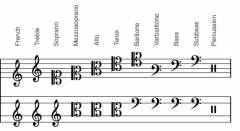![]()
![]()
![]()
Use LEFT and RIGHT arrow keys to navigate between flashcards;
Use UP and DOWN arrow keys to flip the card;
H to show hint;
A reads text to speech;
46 Cards in this Set
- Front
- Back
|
Chromatic Half Step |
Has 1 letter name C–>C# |
|
|
Diatonic Half Step |
adjacent letter name C–>Db |
|
|
Augmented Prime (A1) |
the interval between two notes on the same staff position C and C# -the interval of that |
|
|
Whole Step |
1 chromatic half step + 1 diatonic half step |
|
|
tetrachord |
4 different notes (pitch classes) |
|
|
the major tetrachord |
W,W,h/mi2 |
|
|
Enharmonic Equivalents |
notes which sound the same out of context, but spelled differently, function differently, and are different notes there are 7 * 5 = 35 of them |
|
|
non-theoretical notes |
any sharp or flat before double flat or double sharp |
|

Major Scale Degrees 1-8 |
1. Tonic 2. Supertonic 3. Mediant 4. Subdominant 5. Dominant 6. Submediant 7. Leading tone 8. Tonic |
|
|
key signature |
reflects order of origin |
|
|
tonwille |
what tones want to do |
|
|
interval |
the relationship between 2 notes as defined by: numerical size and quality |
|
|
numerical size (interval) |
the number of letter names inclusively between 2 notes |
|
|
quality (interval) |
whether an interval is major, minor, aug, dim, perfect |
|
|
Families:
Pefect? Imperfect? |
Perfect: 1,4,5,8 Imperfect 2,3,6,7 (Major Minor Family) |
|
|
octaves |
2 notes that have 2:1 ratio frequencies |
|
|
pitch class |
all the notes with the same name regardless of register (bands of highs and lows) C is a pitch class (C1 to C2 to C3...) octaves–ish D# is a pitch class (D#1 to D#2...) |
|
|
register |
bands of highs and lows on a keyboard |
|
|
simple interval (interval simplification) |
an interval whose numerical size is 8 or less |
|
|
compound interval (interval simplification) |
an interval whose numerical size is 9 or more |
|
|
interval inversion |
1. start with a simple interval (8 or less), top note becomes bottom note, bottom note becomes top note. 2. Displace one of the notes by a perfect octave (multiples remain sum of numerical size = 9)
Major <-> minor Perfect <-> Perfect Augmented <-> Diminished
|
|
|
Consonants (intervals in simplified form) |
p8, p1 p5, p4 p4, p5 M3, m6 M6, m3 |
|
|
Dissonants (intervals in simplified form) |
M2, m2 M7, m7 P4. ALL Augmented and Diminished possibilities |
|
|
How do you get Sound? |
1. Matter 2. Vibrations 3. Carrier, such as air 4. Receiver, such as ears 5. CPU - central processing unit (brain) |
|
|
The Fundamental Frequency P8 P5 P4 M3 M6 |
P8 - 2:1 (220 : 110) P5 - 3:2 P4 - 4:3 (440 : 330) M3 - 5:4 (partial) M6 - 5:3 (partial) |
|
|
tonality |
1. the character of a piece of music as determined by the key in which it is played or the relations between the notes of a scale or key. 2. the major/minor monopoly |
|
|
interval class vector for C to C |
254361 2 = #half steps 5 = 5 Whole Steps 1 = Key defining tritones |
|
|
tritone |
A4 d5 |
|
|
Diatonic Modes C, D, E, F, G ,A, B |
C = Ionian D = Dorian E = phrygian F = Lydian (Diralis = "hard b") (mollis soft b) G = Mixolydian A = Aeolian B = Locrian |
|
|
modes vs keys how is modes different |
modes are note specific keys and not |
|
|
performance practice |
-how you perform music that doesn't get written down -don't have to be told what to do -stuff that doesn't get written down |
|
|
what is Musica ficta |
"false music" |
|
|
(regarding Lydian) dirallis mollis |
dirallis = hard b (b natural) mollis = soft b (b flat) |
|
|
modality |
system of modes |
|
|
parallel keys |
keys that have the same tonic F major -> f minor |
|
|
relative keys |
keys that have the same key signature, but are distinct keys G major -> E minor |
|
|
root |
the referential tone of a chord |
|
|
tone |
the referential tone of a key |
|
|
4 qualities of triads? |
Major: major 3rd, perfect 5th Minor: minor 3rd, perfect 5th Diminished: minor 3rd, diminished 5th Augmented: major 3rd, augmented 5th |
|
|
7th Chord Qualities: 1. M7 2. m7 3. V7 4. o7 5. ø7 6. A7 7. m-M 7 |
Q, Triad, 7th 1. M7, M, M 2. m7, m, m 3. V7, M, m 4. o7, d, d 5. ø7, d, m 6. A7, A, M 7. m-M, m, M |
|
|
Figures... |
refer to intervals above the bass |
|
|
Triad Inversions: What is in the bass? Root Positive? 1st Inversion? 2nd Inversion? |
Root Positive - root in bass, 5/3 1st Inversion - 3rd in bass, 6/(3) 2nd Inversion - 5th in bass, 6/4 |
|

Clefs: |
|
|
|
octave equivalence |
ratio of frequencies |
|
|
chord |
3 or more notes when sounded at the same time form a complex sound |
|
|
triad |
a root, a third above root, a 5th above root |

